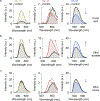Kaleidoscopic fluorescent arrays for machine-learning-based point-of-care chemical sensing
- PMID: 33446959
- PMCID: PMC7802756
- DOI: 10.1016/j.snb.2020.129248
Kaleidoscopic fluorescent arrays for machine-learning-based point-of-care chemical sensing
Abstract
Multiplexed analysis allows simultaneous measurements of multiple targets, improving the detection sensitivity and accuracy. However, highly multiplexed analysis has been challenging for point-of-care (POC) sensing, which requires a simple, portable, robust, and affordable detection system. In this work, we developed paper-based POC sensing arrays consisting of kaleidoscopic fluorescent compounds. Using an indolizine structure as a fluorescent core skeleton, named Kaleidolizine (KIz), a library of 75 different fluorescent KIz derivatives were designed and synthesized. These KIz derivatives are simultaneously excited by a single ultraviolet (UV) light source and emit diverse fluorescence colors and intensities. For multiplexed POC sensing system, fluorescent compounds array on cellulose paper was prepared and the pattern of fluorescence changes of KIz on array were specific to target chemicals adsorbed on that paper. Furthermore, we developed a machine-learning algorithm for automated, rapid analysis of color and intensity changes of individual sensing arrays. We showed that the paper sensor arrays could differentiate 35 different volatile organic compounds using a smartphone-based handheld detection system. Powered by the custom-developed machine-learning algorithm, we achieved the detection accuracy of 97% in the VOC detection. The highly multiplexed paper sensor could have favorable applications for monitoring a broad-range of environmental toxins, heavy metals, explosives, pathogens.
Keywords: Fluorescent compound array; Indolizine; Pattern recognition; machine learning; multiplexing.
Figures





Similar articles
-
Machine learning-assisted array from fluorescent conjugated microporous polymers for multiple explosives recognition.Anal Chim Acta. 2022 Feb 1;1192:339343. doi: 10.1016/j.aca.2021.339343. Epub 2021 Dec 2. Anal Chim Acta. 2022. PMID: 35057934
-
Full Color Tunable Aggregation-Induced Emission Luminogen for Bioimaging Based on an Indolizine Molecular Framework.Bioconjug Chem. 2020 Nov 18;31(11):2522-2532. doi: 10.1021/acs.bioconjchem.0c00467. Epub 2020 Oct 8. Bioconjug Chem. 2020. PMID: 32985867
-
Deep Learning Enabled Universal Multiplexed Fluorescence Detection for Point-of-Care Applications.ACS Sens. 2024 Aug 23;9(8):4017-4027. doi: 10.1021/acssensors.4c00860. Epub 2024 Jul 15. ACS Sens. 2024. PMID: 39010300 Free PMC article.
-
Paper-based optical sensor arrays for simultaneous detection of multi-targets in aqueous media: A review.Anal Chim Acta. 2024 Jul 18;1313:342741. doi: 10.1016/j.aca.2024.342741. Epub 2024 May 17. Anal Chim Acta. 2024. PMID: 38862204 Review.
-
Conjugated Polyelectrolyte-Based Sensor Arrays: from Sensing Mechanisms to Artificial Sensory System Conceptualization.ACS Appl Mater Interfaces. 2025 Mar 19;17(11):16396-16409. doi: 10.1021/acsami.4c22848. Epub 2025 Mar 6. ACS Appl Mater Interfaces. 2025. PMID: 40048404 Review.
Cited by
-
Fluorescence-Based Portable Assays for Detection of Biological and Chemical Analytes.Sensors (Basel). 2023 May 25;23(11):5053. doi: 10.3390/s23115053. Sensors (Basel). 2023. PMID: 37299780 Free PMC article. Review.
-
Multifunctional Nanobody Fusion Proteins in Immunoassays: Diverse Strategies for Enhanced Analytical Performance.Trends Analyt Chem. 2025 Nov;192:118404. doi: 10.1016/j.trac.2025.118404. Epub 2025 Aug 2. Trends Analyt Chem. 2025. PMID: 40860993 Free PMC article.
-
Smartphone-based platforms implementing microfluidic detection with image-based artificial intelligence.Nat Commun. 2023 Mar 11;14(1):1341. doi: 10.1038/s41467-023-36017-x. Nat Commun. 2023. PMID: 36906581 Free PMC article. Review.
-
Patterning of Organic Semiconductors Leads to Functional Integration: From Unit Device to Integrated Electronics.Polymers (Basel). 2024 Sep 15;16(18):2613. doi: 10.3390/polym16182613. Polymers (Basel). 2024. PMID: 39339077 Free PMC article. Review.
-
Predicting speech discrimination scores from pure-tone thresholds-A machine learning-based approach using data from 12,697 subjects.PLoS One. 2021 Dec 31;16(12):e0261433. doi: 10.1371/journal.pone.0261433. eCollection 2021. PLoS One. 2021. PMID: 34972151 Free PMC article.
References
-
- Jalal AH, Alam F, Roychoudhury S, Umasankar Y, Pala N, Bhansali S. Prospects and Challenges of Volatile Organic Compound Sensors in Human Healthcare. ACS Sens. 3 (2018) 1246–1263. - PubMed
-
- Oh J-W, Chung W-J, Heo K, Jin H-E, Lee BY, Wang E, Zueger C, Wong W, Meyer J, Kim C, Lee S-Y, Kim W-G, Zemla M, Auer M, Hexemer A, Lee S-W. Biomimetic virus-based colourimetric sensors. Nat. Commun 5 (2014) 3043. - PubMed
-
- Shrivastava S, Trung TQ, Lee N-E. Recent progress, challenges, and prospects of fully integrated mobile and wearable point-of-care testing systems for self-testing. Chem. Soc. Rev 49 (2020) 1812–1866. - PubMed
Grants and funding
LinkOut - more resources
Full Text Sources
Other Literature Sources

